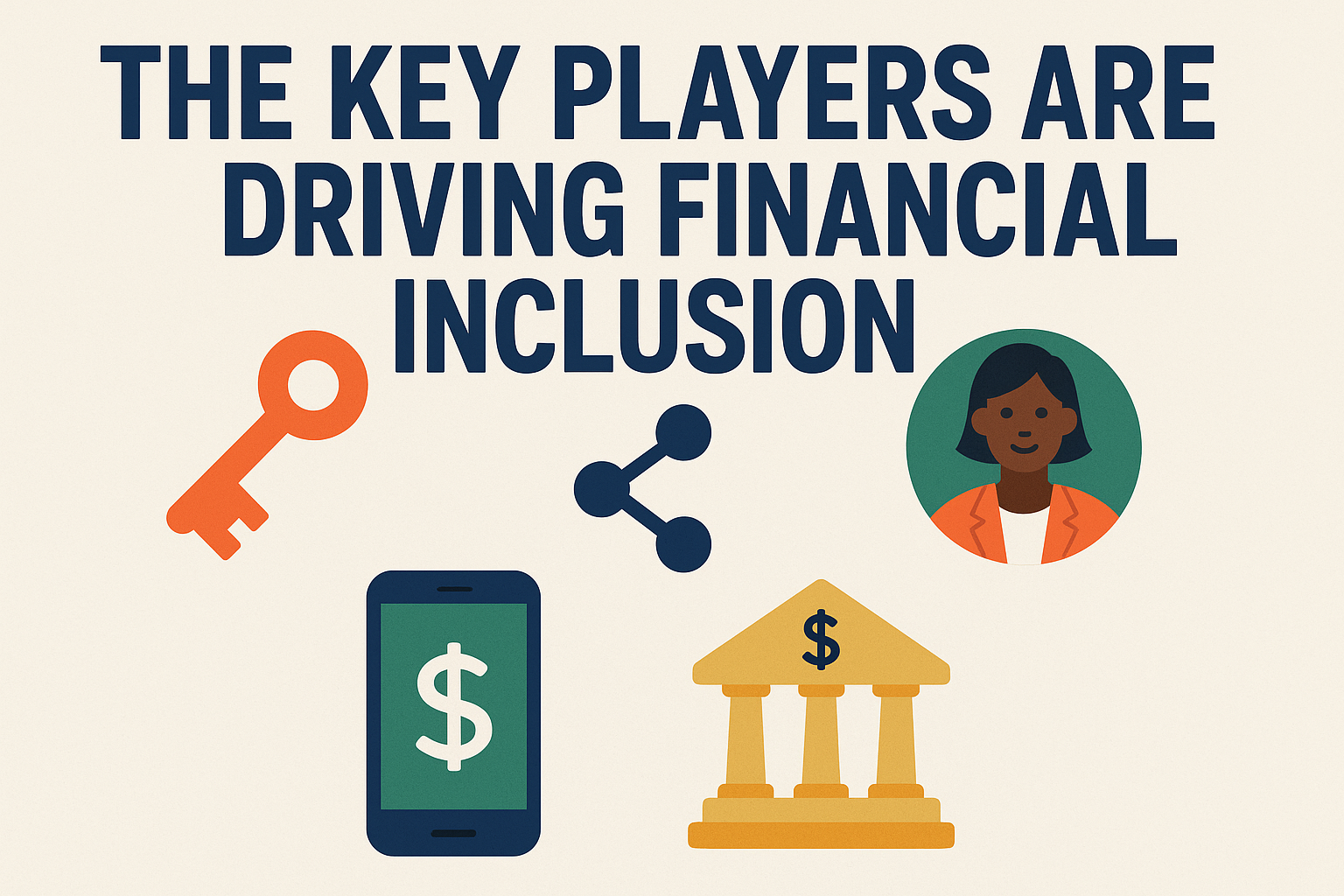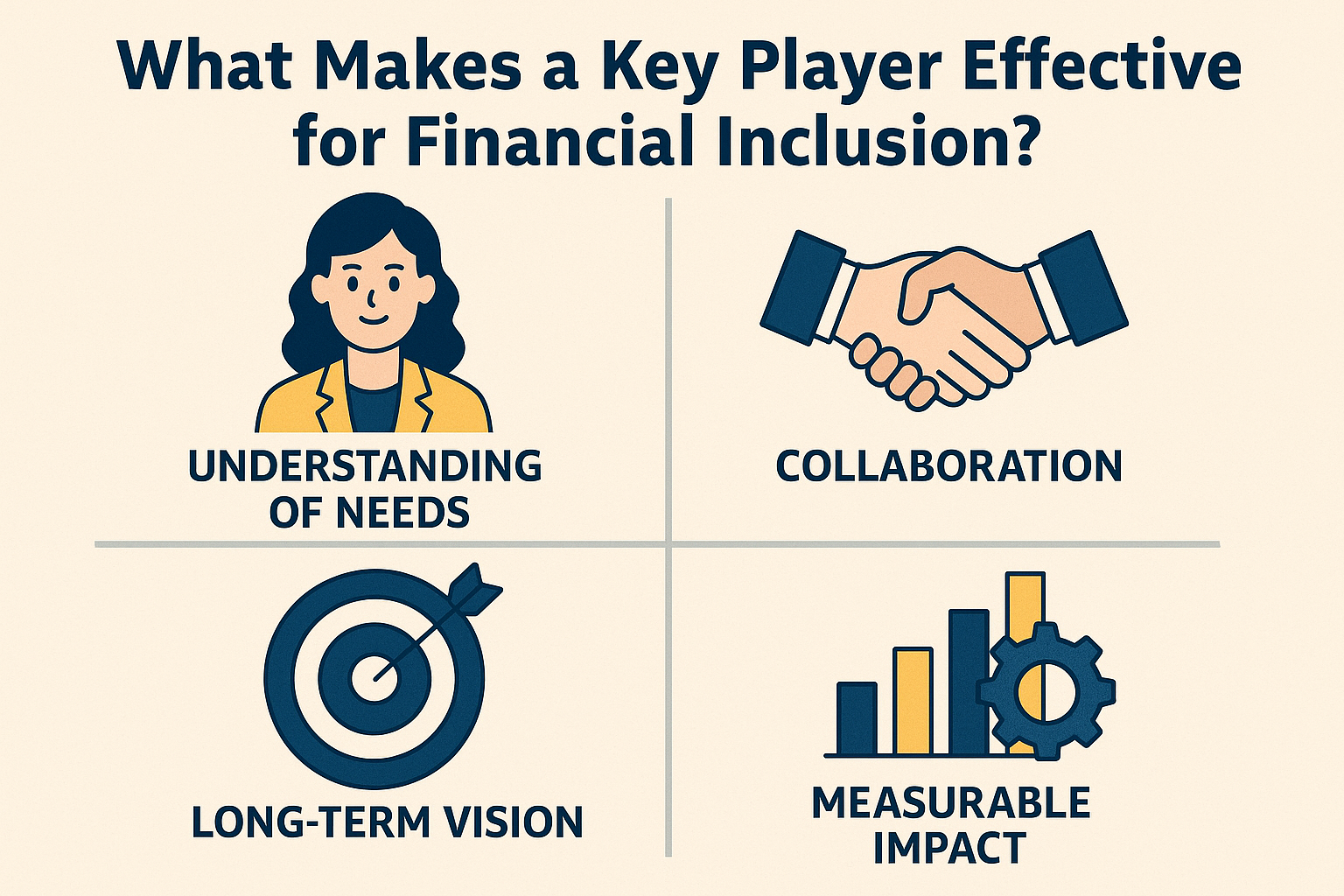In an era where access to financial services is increasingly seen not just as a privilege but as a fundamental right, the question of who truly advances this access becomes ever more urgent. The blockchain technology key players—from fintech startups and global banks to regulators and technology vendors—claim they are driving financial inclusion. But are they really? Or are they merely bystanders in an ecosystem that needs grassroots engagement, regulatory clarity and infrastructure? In this article, we’ll dive deep into how blockchain technology key players shape financial inclusion, what roles they play, and whether their involvement is transformational or superficial.
What is Financial Inclusion and Why It Matters
Financial inclusion is the concept of ensuring individuals and businesses—particularly those previously excluded—have access to useful and affordable financial services, including payments, savings, credit, insurance and remittances. According to global data, billions of adults remain under-banked or entirely unbanked. A full grasp of the advantages of inclusion shows us why blockchain technology key players matter: reducing costs, increasing transparency, expanding reach. Studies confirm that blockchain technology can lower transaction fees, reduce infrastructure barriers and open up new models of credit and service delivery. Financial inclusion is not only a moral imperative but a driver of economic growth, innovation and equity in the digital age.
The Role of Blockchain Technology Key Players in Promoting Inclusion
When we speak of blockchain technology key players, we refer to a wide ecosystem: the fintech companies leveraging blockchain protocols, large financial institutions adopting distributed-ledger systems, regulatory bodies setting frameworks, and technology providers building infrastructure. Together they influence how and whether blockchain makes inroads into underserved markets.
Fintech innovators and start-ups
Start-ups and fintech innovators often lead the charge when it comes to applying blockchain solutions to financial inclusion. For example, platforms that use blockchain for remittances, peer-to-peer lending, identity verification and micro-insurance demonstrate the promise of innovation for the unbanked. One study notes how blockchain “allows individuals to access services without relying on traditional banking infrastructure.”These organisations are part of the blockchain technology key players with high potential to leap-frog conventional barriers.
Traditional financial institutions
Banks and legacy financial institutions are also among the key players. They bring scale, capital, trust and regulatory experience to the table. However, their adoption of blockchain is often cautious and incremental. The question is whether they will act as true enablers of inclusion—or merely modernise existing exclusionary structures. For instance, research on developing markets shows blockchain may help “modernize and even replace the infrastructure that currently supports international payments and remittances” thereby contributing to inclusion.
Regulators and policy-makers
Policy frameworks and regulation are essential if blockchain solutions are to reach excluded populations. Without appropriate regulation, issues of identity (KYC), digital literacy, infrastructure and trust loom large. A major study found the adoption of blockchain for financial inclusion is “impeded by regulatory uncertainties, limitations in technological infrastructure, and cryptocurrency volatility. Thus regulators are also blockchain technology key players, whether they enable or hinder progress.
Infrastructure and technology firms
The technological underpinnings – such as distributed ledger platforms, identity systems, mobile-first wallets, smart contracts – are built by system vendors and developers. Without them, even the best-intended inclusion strategy cannot scale. For example, blockchain has been shown to support peer-to-peer transactions and smart-contract-based micro-lending in under-served regions. Hence these tech firms are also part of the ecosystem of key players.
These Key Players Are Really Driving Financial Inclusion?

Having identified the types of actors involved, we must ask: are they delivering on inclusion? Let’s evaluate both the promise and the pitfalls.
The promise of inclusion
-
The power of blockchain to reduce costs: By cutting out intermediaries, blockchain can lower transaction and remittance fees, making services affordable for low-income users. For example, via digital wallets built on DLT (distributed ledger technology) that connect vulnerable users across borders and bypass heavy fees.
-
Expanded access and reach: Blockchain, combined with mobile connectivity and digital identity, enables new users to enter the financial system—even in places lacking branch infrastructure. A study found blockchain as a key enabler of “digital financial inclusion” in regions previously excluded.
-
Transparency and trust: For communities where institutional trust is weak, blockchain’s immutable ledger promises reliable records of transactions, credit history and identity verification. This can unlock services like micro-insurance or lending in remote regions.
-
Innovation in financial products: Smart contracts, tokenisation of assets, peer-to-peer credit and mobile wallets built on blockchain open up novel models tailor-made for underserved populations. For instance, community tokens used in Kenya to build credit history where traditional banks fail.
All these point to real potential. And yes, the key players mentioned—fintechs, banks, regulators, tech firms—are actively building solutions.
The reality: Are they bystanders?
However, several limitations signal that many “key players” may still be bystanders rather than enablers.
-
Infrastructure and digital-divide gaps: In many developing regions, beyond blockchain, the broader digital infrastructure (internet access, smartphones, power, literacy) is weak. Without that, even strong solutions falter. A study in Morocco showed adoption was constrained by “low financial literacy, regulatory uncertainty, digital infrastructure.”
-
Regulatory ambiguity and risk: Blockchain solutions often operate in grey zones. Unclear regulation, lack of consumer protection and concerns over privacy/criminal misuse can hamper adoption. As one report notes: many regulators are still “searching for a way to regulate and facilitate the growth of the industry” around blockchain.
-
Focus on pilot projects rather than scale: Some initiatives are proof-of-concepts rather than full roll-outs to millions of unbanked. Key players may engage at high level, but grassroots deployment often lags. The difference between promise and actual inclusion remains.
-
Misaligned incentives: Financial institutions and tech firms may prioritise profitability, institutional efficiency or tokenisation for investors rather than serving the poorest. Inclusion may be secondary. If key players are serving the “banked better”, they may inadvertently perpetuate exclusion.
-
Volatility and accessibility issues: In some cases blockchain solutions tie to cryptocurrencies with high volatility or complex user experiences. That discourages risk-averse low-income users. A study states “cryptocurrency volatility” and technological limitations impede widespread adoption.
What Makes a Key Player Effective for Financial Inclusion?

When we talk about an effective “key player” in the context of financial inclusion, certain attributes stand out. For blockchain solutions to truly include the excluded, these attributes matter.
Community-centric design
Solutions must be designed with the underserved in mind: mobile-friendly, low-cost, local language, minimal documentation, minimal infrastructure. Key players that embed local context tend to deliver better inclusion outcomes.
Collaboration and ecosystem building
Blockchain alone cannot solve all barriers. Effective players work across sectors: telecoms, regulators, banks, NGOs, local communities. For example, combining blockchain identity systems with mobile operators and local agents. Partnerships matter.
Clear regulation and consumer protection
An effective key player will engage regulators early, adhere to consumer protection standards, ensure transparency, build trust. Without regulatory clarity and user trust, inclusion stalls.
Infrastructure readiness
Good players invest in enabling the underlying infrastructure (connectivity, digital identity, agent networks). They recognise that blockchain is one part of a broader stack. One study emphasises that while blockchain has potential, “technological infrastructure” limitations remain major obstacles.
Scale and sustainability
Pilot projects are useful, but the real test is whether solutions scale sustainably. Key players need business models that support long-term operations, affordable services and wide adoption.
Measurable outcomes
Tracking metrics such as how many unbanked people gained access, how much transaction costs dropped, how many microloans were issued. Key players should demonstrate real impact, not just hype.
Successes and Failures
Let’s look at real-world illustrations to see how blockchain technology key players have performed.
Remittances and Wallets
In one notable example, a blockchain-enabled digital wallet service in East Africa allowed refugees and low-income users to send, receive and store value via mobile phone, regardless of whether they had traditional banking access. This shows how blockchain with mobile access and a supportive ecosystem can make a difference. Here the key players included fintech startup + mobile operator + community outreach.
Cryptocurrencies in Developing Economy
In Morocco, there is clear potential of blockchain, cryptocurrency and DeFi to improve access for the unbanked. But the study also emphasises how key limitations — regulatory uncertainty, infrastructural gaps, digital literacy — still hamper adoption. Here the key players exist (tech firms, regulators), but their impact remains partial.
Challenge Example: Lending and Identity
While blockchain solutions promise peer-to-peer credit and identity verification, many projects remain pilots. The “role of blockchain technology in enhancing financial inclusion” study points out that for many under-banked populations the leap from pilot to scale remains unfulfilled. Thus key players may still be watching rather than fully acting.
Critical Discussion: Are Key Players Enough?
Even when key players act, is that sufficient? Let’s examine some deeper issues.
Inclusion requires more than technology
Technology (like blockchain) is necessary but not sufficient. Without complementary factors — education, agent networks, identity verification, local language support — even the best blockchain solutions may not reach marginalised populations. Many key players underestimate this.
The danger of exclusion via new technology
Sometimes new technologies replicate old exclusion patterns. If blockchain-based services require smartphones, high literacy or internet access, they may benefit the “already banked” more than the unbanked. Key players must guard against this.
Dependency on institutional frameworks
Blockchain solutions often need supportive regulation, digital ID systems, legal frameworks for smart contracts, consumer protection. If the regulatory environment is weak or hostile, key players may be stymied. Many developing economies lag here.
Profit vs purpose
When the key players are primarily motivated by profit, there is risk that “financial inclusion” becomes a marketing buzzword rather than a mission. Inclusion projects may be expensive, risky, or yield low profitability. Without securing sustainable business models, key players may retreat.
Measurement of impact
Key players need to show results: How many previously excluded people now access financial services? How has cost dropped? What credit access was enabled? Without such metrics, it is hard to evaluate whether key players are driving inclusion or simply deploying technology.
What Should Key Players Do to Drive Genuine Financial Inclusion?
If we accept that blockchain technology key players can potentially make a difference—but that so far progress is mixed—what should they focus on to shift from bystander to driver?
Invest in local partnerships
Key players should partner with local organisations, community banks, micro-finance institutions, telecom operators. That grounds the solution in local reality and helps scale.
Focus on user experience and affordability
Poor and unserved populations need low-cost, simple interfaces, local languages, minimal friction. Key players must prioritise accessibility.
Engage proactively with regulation and standard-setting
Key players should work with regulators to craft frameworks that enable innovation while protecting consumers. This includes digital identity, smart contract legality, data privacy.
Build metrics and transparency
Key players should publish their impact metrics: how many unbanked reached, cost reductions, service uptake, credit extended, etc. This builds accountability.
Combine blockchain with other technologies
Blockchain alone will not suffice. Combining with mobile money, agent networks, biometrics, AI-based credit scoring helps deliver real inclusion.
Ensure scalability and sustainability
Pilot projects are useful, but key players must design business models that scale to millions of users with affordable pricing, decent margins or subsidies.
What Lies Ahead: The Future of Blockchain and Financial Inclusion
Looking forward, the intersection of blockchain and financial inclusion promises several trends, and the role of the key players will evolve.
Decentralised finance (DeFi) and tokenisation for inclusion
Tokenisation of assets and DeFi protocols may create new pathways to savings, credit and investment for previously excluded populations. Some key players are exploring these. If key players adopt inclusive strategies here, we may see breakthrough models.
Central bank digital currencies (CBDCs) and public-blockchain intersections
With more countries exploring digital currencies, the role of blockchain infrastructures and key players within them could be magnified. Regulation will be crucial. Key players who engage early may shape both infrastructure and inclusion policy.
Identity, trust and infrastructure bridging
Blockchain-based identity systems may unlock access for millions without formal IDs. The key players who build interoperable systems with mobile and telecom partners may become the game-changers.
A push towards metrics and impact-focussed solutions
As inclusion becomes a major global agenda (e.g., Sustainable Development Goals), key players will face pressure to demonstrate impact, not just innovation. Those who deliver will stand out.
Conclusion
In conclusion, the time has come to ask: are the blockchain technology key players truly driving financial inclusion—or are they mostly bystanders, waiting for the perfect moment? The answer is: both. Many players are actively engaging, innovating and building. But many more remain in pilot phase, grappling with infrastructure, regulation, business models and user adoption. If those key players commit to local focus, collaboration, affordability, measurable impact and scalable models, then blockchain technology key players can legitimately be seen not just as observers but as drivers of financial inclusion.
So see more: Pokemon Crypto Blockchain Collectibles in Pokemon Universe


